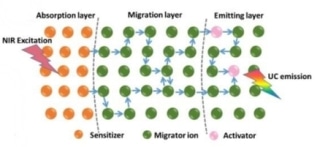Feb 1 2018
A research group headed by Professor Hong Zhang, of photonic nanochemistry, and Professor Evert Jan Meijer, of computational chemistry, from the University of Amsterdam’s Van’t Hoff Institute for Molecular Sciences, has considerably enhanced the basic knowledge of photon upconversion in nanoparticles.
Using the combined strategy of advanced spectroscopy and theoretical modeling, the researchers were successful in demonstrating that the migration of excitation energy has a higher impact on the upconversion dynamics. In a paper published recently in Angewandte Chemie, the scientists report the way “dopant ions spatially separated” (DISS) nanostructures can be used for customizing the upconversion dynamics.
 The upconversion process in the “dopant ions spatial separated” nanostructure. Here, the three basic processes of photon absorption, energy migration and UC emission, are spatially separated. (Image credit: HIMS)
The upconversion process in the “dopant ions spatial separated” nanostructure. Here, the three basic processes of photon absorption, energy migration and UC emission, are spatially separated. (Image credit: HIMS)
Upconversion is a technique where one photon is liberated when a number of photons with lower energy are absorbed, thereby “jacking” the light from low to high frequency. Usually, lanthanide ions are used for doping upconversion materials because they have the ability to shift the near infrared (NIR) light from an economic continuous wave milliwatt laser toward visible, higher frequencies and also toward the ultraviolet (UV) spectral region. Prospective applications include high-density data storage, photo-induced therapy, super resolution spectroscopy and anti-counterfeiting and biological imaging.
For many years, upconversion luminescence dynamics have been considered to be governed absolutely by the liberated ions and their interactions with nearest sensitizing ions. The present study indicates that this is not true for nanostructures. Zhang, Meijer, and their colleagues indicate that in nanocrystals, the luminescence behavior is critically impacted by the excitation energy migration process.
The study was carried out in collaboration between the HIMS teams of professors Hong Zhang (photonic nanochemistry) and Evert Jan Meijer (computational chemistry), and the team of professors Xianggui Kong and Hong Zhang at Changchun Institute of Optics, Fine Mechanics and Physics (CIOMP), Chinese Academy of Sciences (CAS).
The scientists unearthed the close link between the random character of the energy migration and the upconversion luminescence time behavior through a complementary strategy of advanced spectroscopy and time-resolved Monte Carlo simulation. They used the (DISS) nanostructures as model systems, in which sensitizers and activators are positioned in distinctive spatial regions of a single nanoparticle. The impact of energy migration can be quantitatively illustrated by adjusting the thickness of the migration layer or by modifying the concentration of the migrator ion dopant in the migration layer.
Consequently, the researchers showed that, due to its random character, the migration of the excitation energy between any two positions in the crystal requires more time than that needed for a straight point-to-point energy transfer.
By using this new basic understanding, the scientists could effectively regulate the upconversion luminescence time behavior, the rise or decay process, by adjusting the energy migration paths in different explicitly designed DISS nanostructures. This outcome is crucial for the use of this kind of materials in high density data storage, super resolution spectroscopy, and anti-counterfeiting and biological imaging.